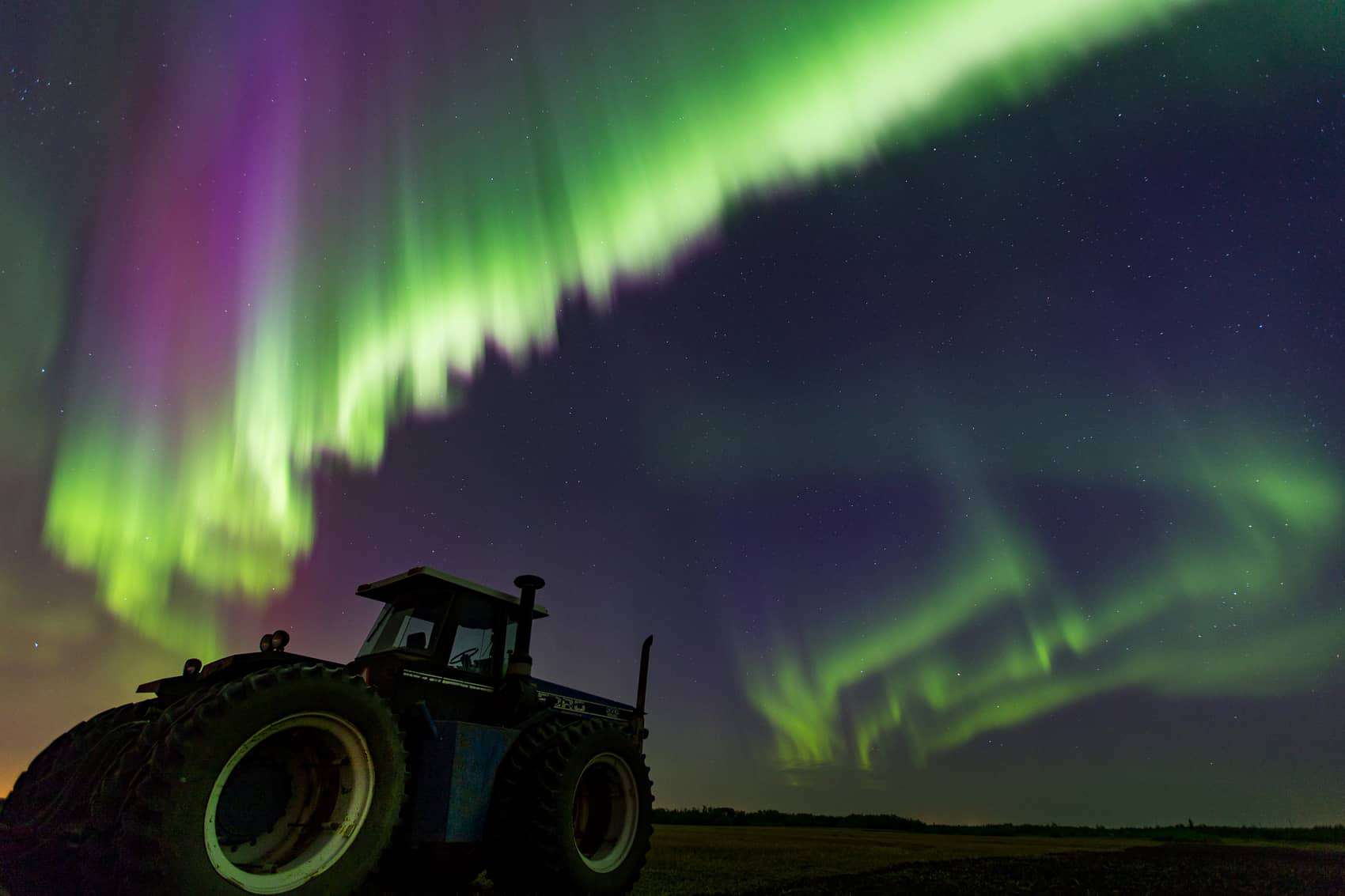Spending your evenings under the stars can be a truly rewarding pastime. The night sky has a way of stretching the limits of our creativity, it can ignite our imagination, and it has the ability to soothe a troubled mind. As carefree kids, exploring the universe all seemed so simple – just go outside after dark, look up and the grandeur of the cosmos would play out above your head. As grown-ups, successfully exploring the night sky requires significantly more understanding of that cosmic ballet. Here are five things you should know about the night sky before heading out to view the mysteries of the universe.
– Photos by Shane Turgeon
Helpful Links:
The Seasonal Sky
Unbeknownst to many, the starry sky changes with the seasons. While many constellations may be seen year round at our latitude – further lending to the belief that the sky is always the same – many others are only visible during certain times of the year. These constellations are often referred to as the summer and winter constellations, though depending on the time of year and time of night that you’re viewing, you may still be able to see them through the spring and fall seasons as well.
There’s no question that stargazing during the summer months is far more comfortable and enjoyable than in the winter months here in Alberta – mosquitos notwithstanding! Some of the more recognizable summer constellations include Perseus and Pegasus, Hercules, Scorpius, Sagittarius, Ophiuchus, and the summer triangle asterism, itself not a constellation per se, but a key marker in the sky that houses the constellations of Cygnus the Swan, Lyra the Harp, and Aquila the Eagle. In addition to all of the wonderful constellations, the summer sky is also well-known for the prominence of the milky way core. This is the brightest part of our milky way galaxy and when viewed from a truly dark location, is brightly visible to the naked eye.

Perhaps the most recognizable constellation of the winter sky is Orion, the Hunter. The three stars of Orion’s belt make up a brightly visible asterism in the winter sky and point directly to Sirius, the brightest star in the sky. Other notable winter constellations include Gemini, Taurus, Auriga, Canis Major and Minor and the Pleiades star cluster. Though not as bright as the summer core, the winter milky way is visible throughout these long, cold months as well.
But what about the Big Dipper?! What about the Little Dipper?! What about Cassiopeia?! At our latitude, those well-known sights are known as circumpolar constellations and are visible year round as they spin around Polaris, the North Star; a point forever fixed (at least within our lifetimes) and unmoving in a sky that’s constantly on the move.

App tip: if you’re looking for a great app that helps you identify planets, stars and constellations while showing you exactly what’s overhead, check out Star Walk 2 from Vito Technology.
The Twilights
It goes without saying that the best time for stargazing is when the sun has set and the sky is dark. But when does the sky actually get DARK, dark? To know that we must first understand twilight and it’s three different stages. Twilight is defined as the time between day and night, when there is light in the sky but the sun is below the horizon. The first stage of twilight is Civil twilight and is when the sun is 6 degrees below the horizon. Next is Nautical twilight, when the sun is between 6 and 12 degrees below the horizon, followed by Astronomical twilight, when the sun is between 12 and 18 degrees below the horizon. Lastly comes Astronomical Night, the period when the sky is darkest between sunset and sunrise and the best time to stargaze. At our latitude here in Alberta, we don’t get any darker than Astronomical twilight from late-May to late-July, which makes stargazing and night sky photography more challenging.
Pro-tip: a quick Google search of Astronomical Night will let you know what time it starts from wherever you’re searching from.
The Moon
La lune, that bright, big, beautiful ball in the sky! A pillar of romance. A guide for lonely travelers. And also really darned annoying when it comes to stargazing, aurora watching and night sky photography! Don’t get me wrong, I LOVE the moon. It’s a special viewing experience unto itself but when it’s out, especially when it’s at its fullest, it washes out the sky, diminishing the stars and making even the strongest aurora shows seem faint. New moon and day moon windows offer the best periods for moon-free viewing so if you’re planning to head out for a night of stargazing, make sure the moon isn’t going to interfere with your plans. But then again, if you’re just heading out for a make out session with your bae, maybe those moonlit nights are just the magic you’re looking for!
App tip: Sky Live is a wonderful app which lets you know at a glance what the moon is doing, what other planets, stars and constellations will be visible and even what time the International Space Station (ISS) will be making a flyby!
Light Pollution
More than just the bane of night sky viewers, light pollution is fast becoming a major environmental concern. Here in Alberta we have some of the worst light pollution in western North America which makes finding truly dark skies difficult and frustrating as light from nearby cities, towns and industry sites can completely wash out the night sky. Even the Beaver Hills Dark Sky Preserve east of Edmonton is situated in an area of intense light pollution from the city (Bortle 5) making viewing difficult. Light pollution is measured on the Bortle Scale, created by John E. Bortle in 2001. It’s a 9-point scale that measures the intensity of light pollution ranging from the darkest possible skies (Bortle 1 and 2) to the most intensely bright (Bortle 6 through 9) as found in cities. Along the Highway 14 corridor, east of Edmonton one can find Bortle 3 skies and wonderful stargazing opportunities in abundance.

App tip: Astrospheric is a great app that shows the Bortle scale map as well as cloud cover, transparency, jet stream, dew point, and much, much more.
Clouds
This one seems like a no-brainer. If it’s cloudy, you’re probably not going to have a banner evening of stargazing. Yet it’s amazing how frequently one hears comments from people saying they drove miles to see the aurora without ever considering if it was cloudy or not. Checking the forecast and cloud cover apps should be the first thing you do before planning a night out. Remember to always give them a double or triple check before heading out the door as the weather can change quickly here in Alberta. But most importantly, just look up! The apps don’t always get it right and sometimes there are nice clear sky windows right where you are when the apps say there aren’t.
App tip: three of the best and most commonly used apps for checking cloud cover are Astrospheric, Ventusky and Windy. While casual stargazers likely only need to have one of these apps, dedicated chasers will check all three against each other to find the optimal clear sky locations during new moon windows or celestial events.
—
About the Author: Shane Turgeon has long been drawn to the beauty and mystery of the night sky. As an 80s kid growing up at the end of a dirt road in the middle of nowhere Saskatchewan, he was lucky to experience truly dark skies. Fuelled by a love of science fiction, he’d spend many a summer night under the stars, letting his imagination take him to far off places while gazing out upon the core of our galaxy. Nowadays Shane is an accomplished and award-winning night sky photographer and tries to spend as much time as possible away from the city, under the darkest skies Alberta has to offer. Visit his website at shaneturgeonphotography.com and follow him on Instagram @shane_turgeon

